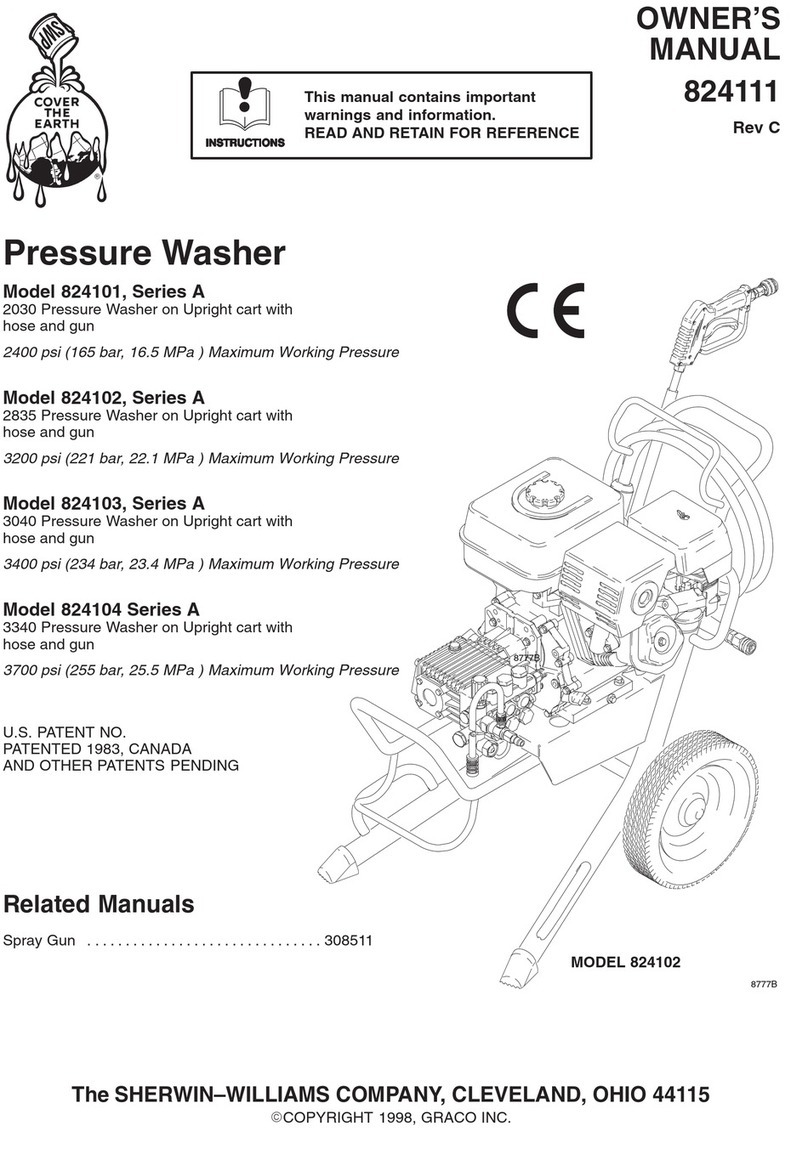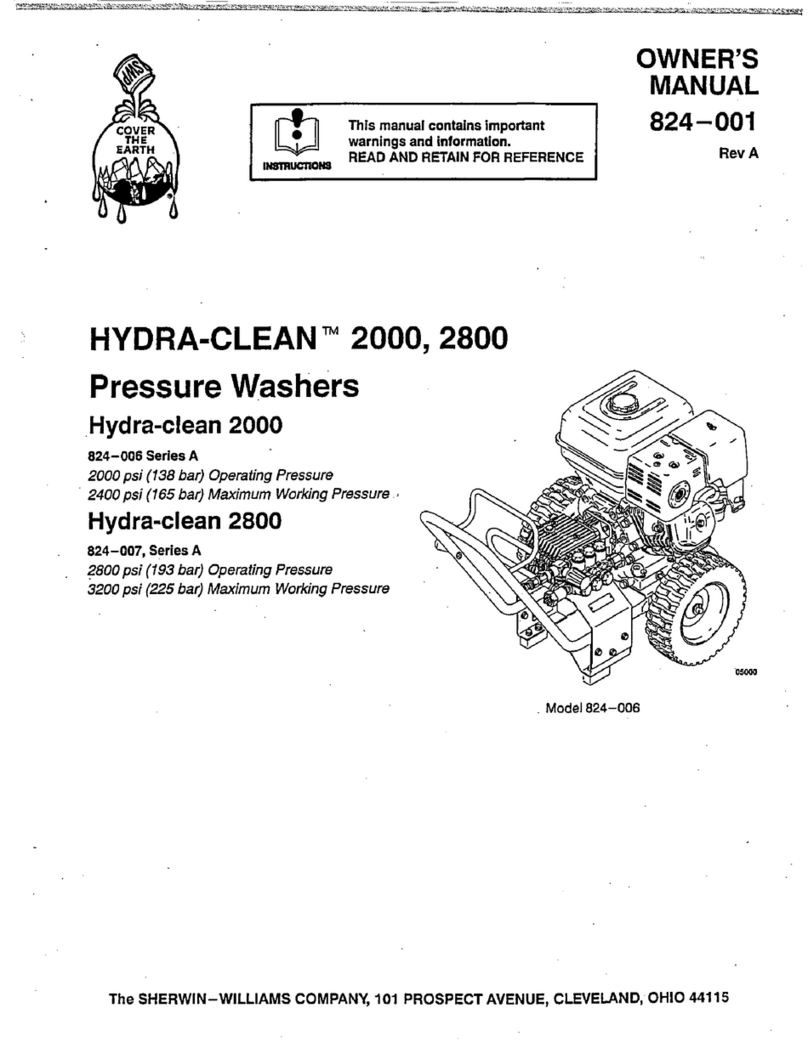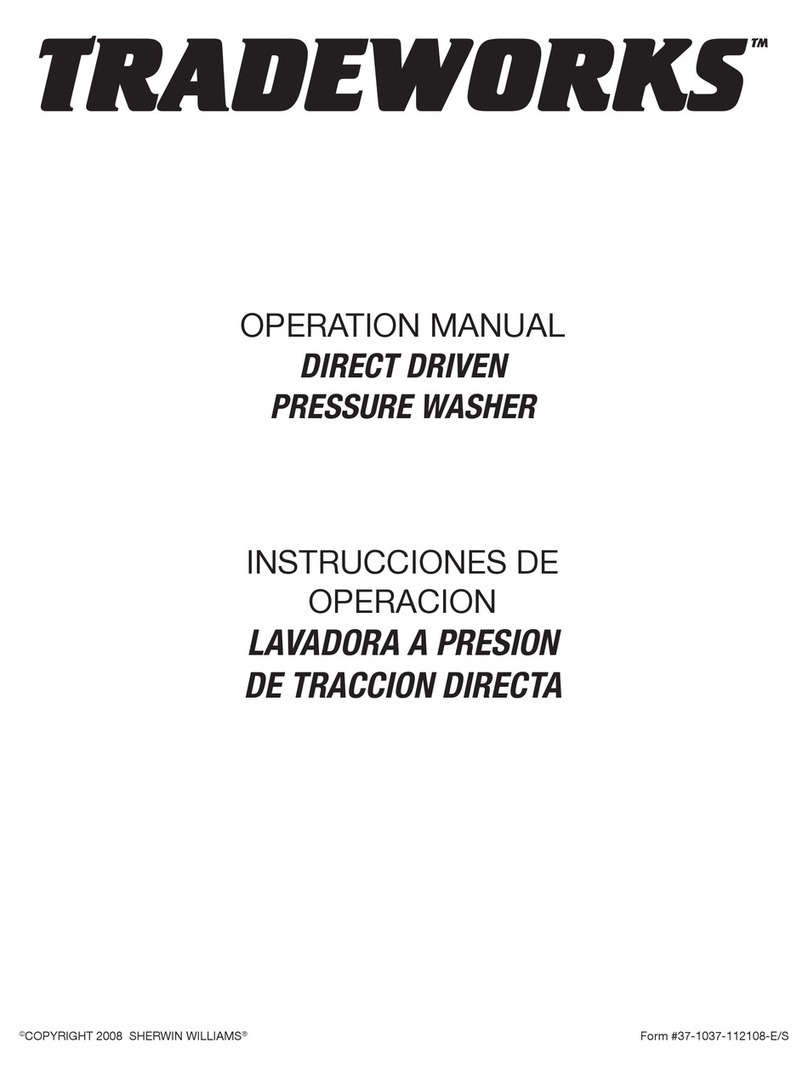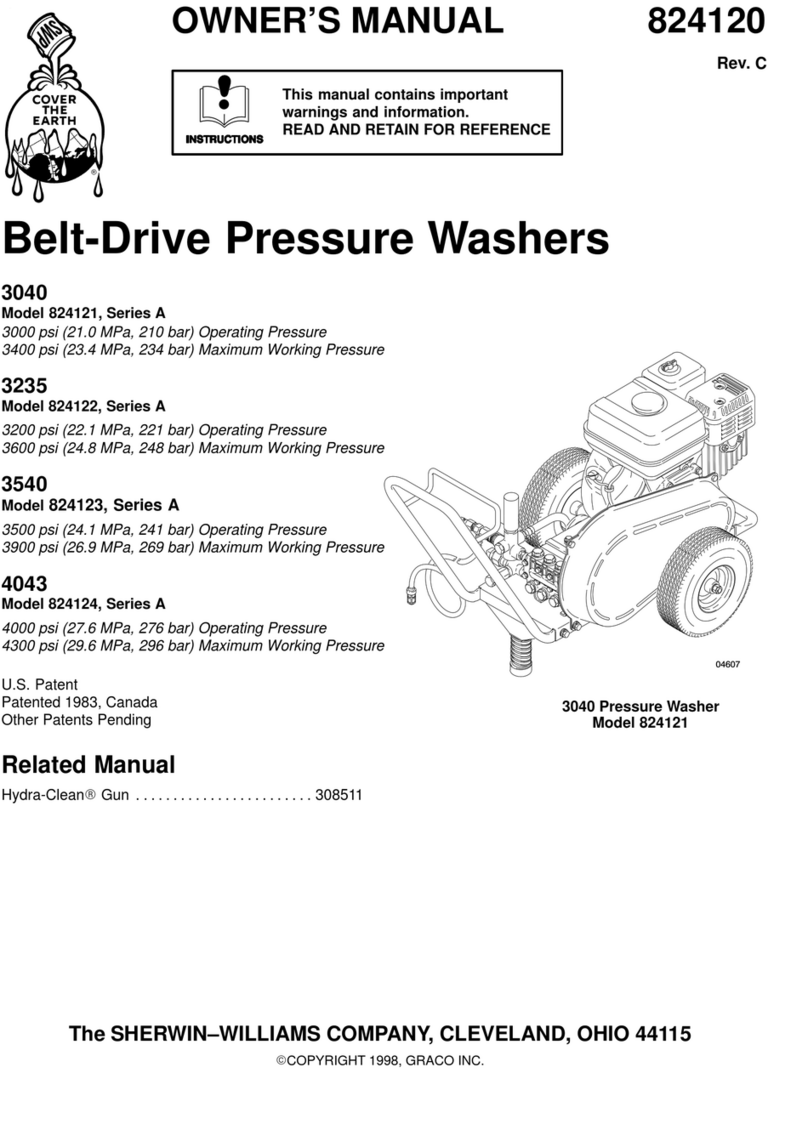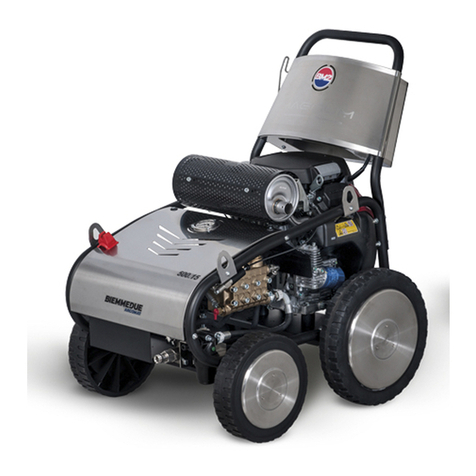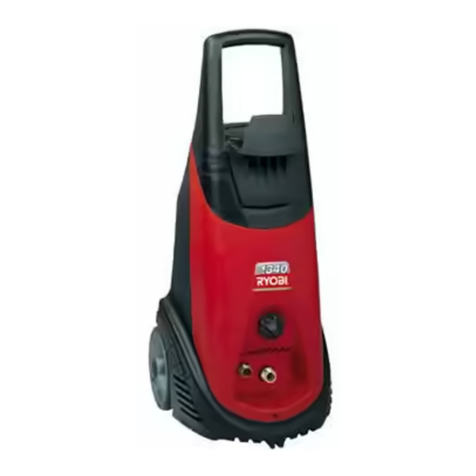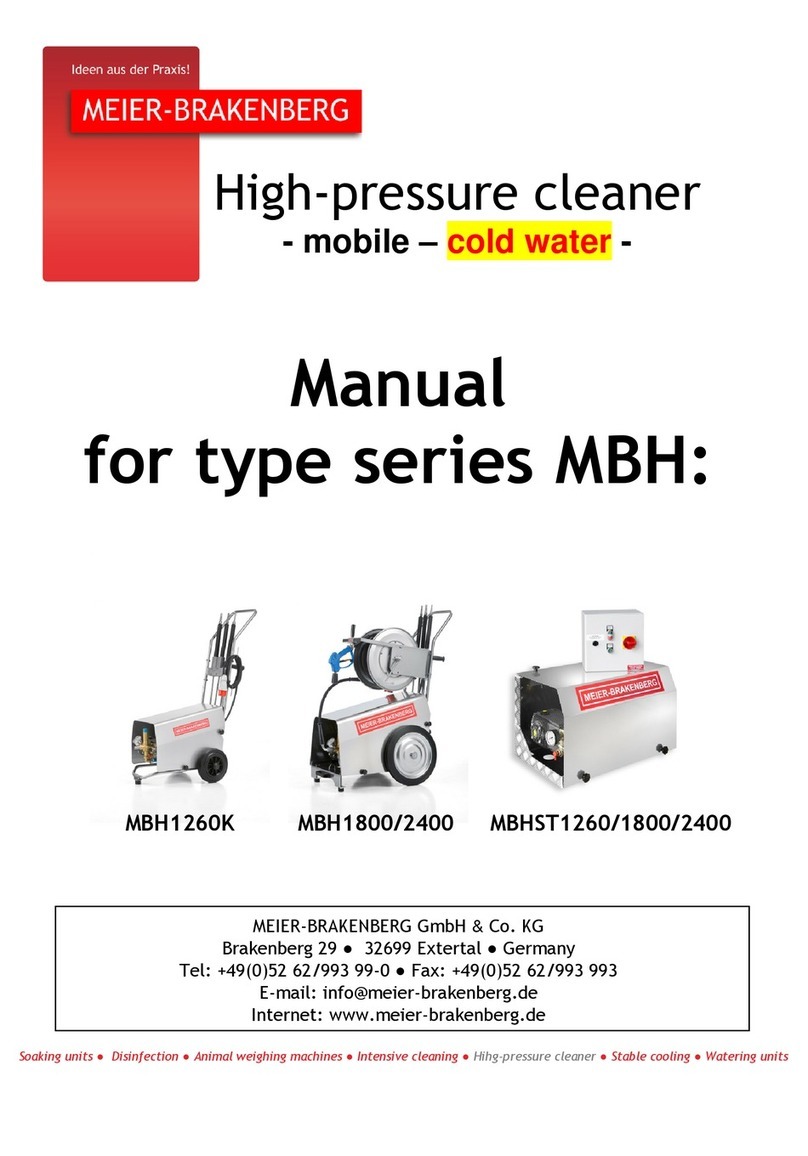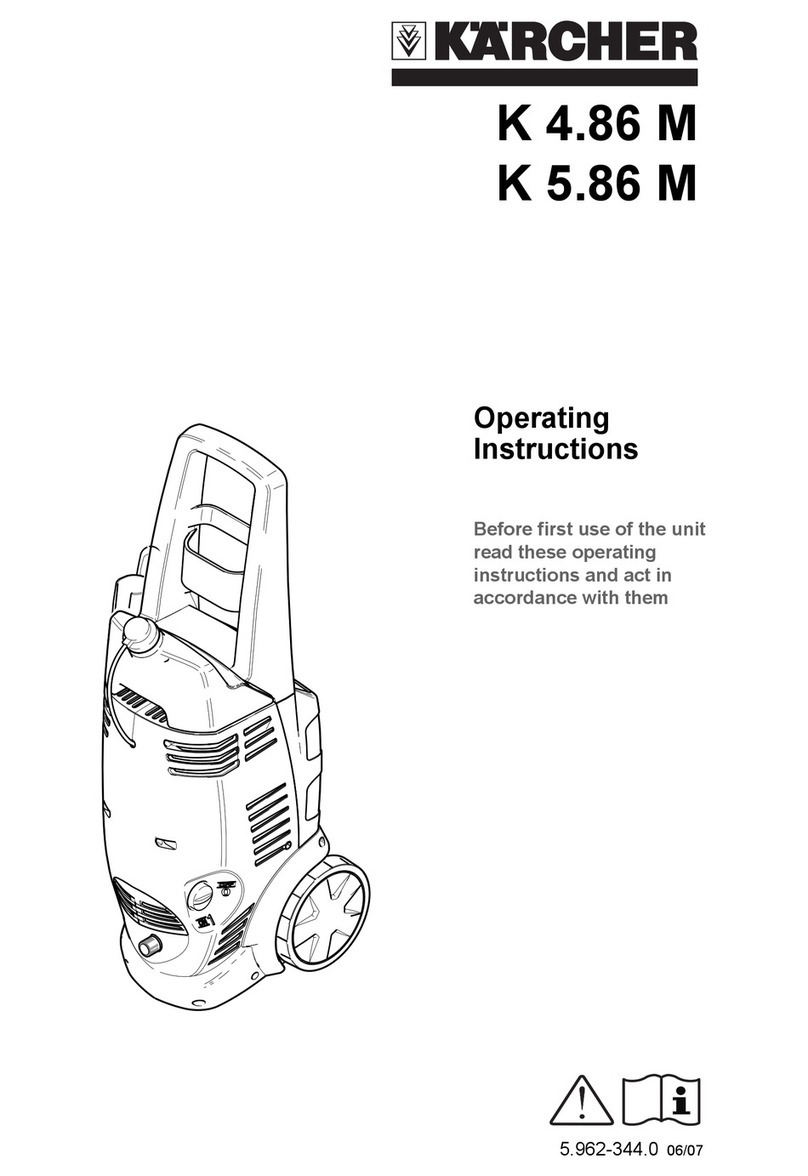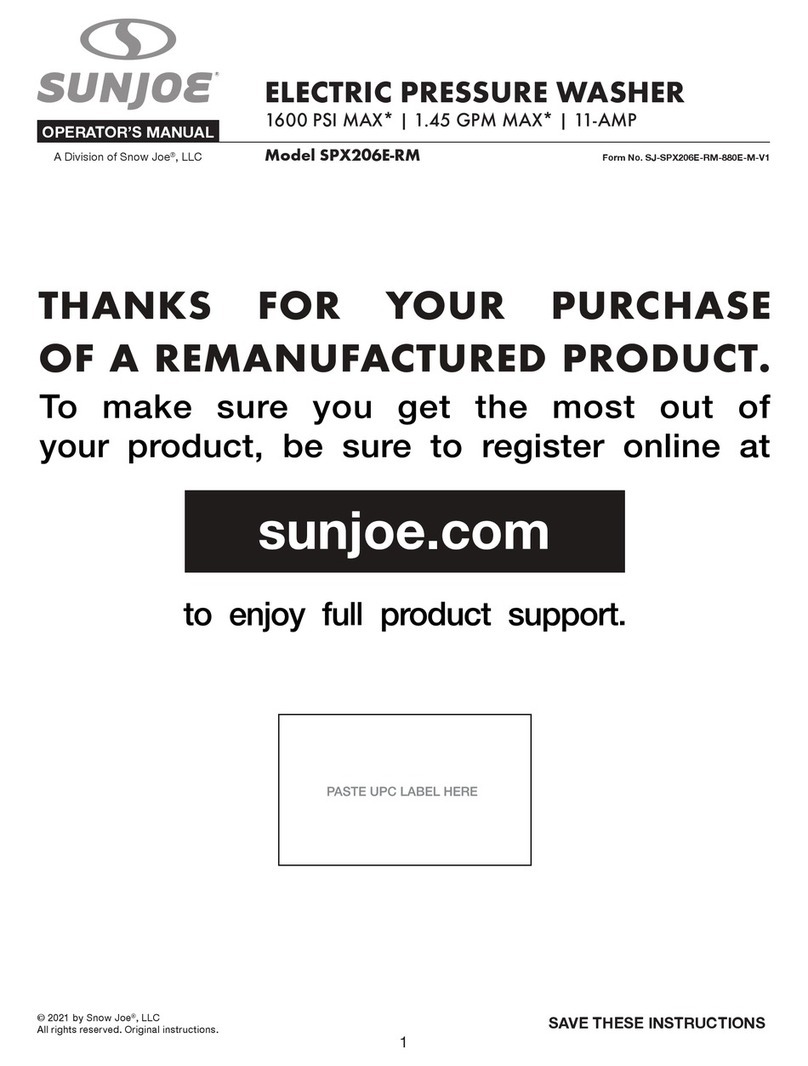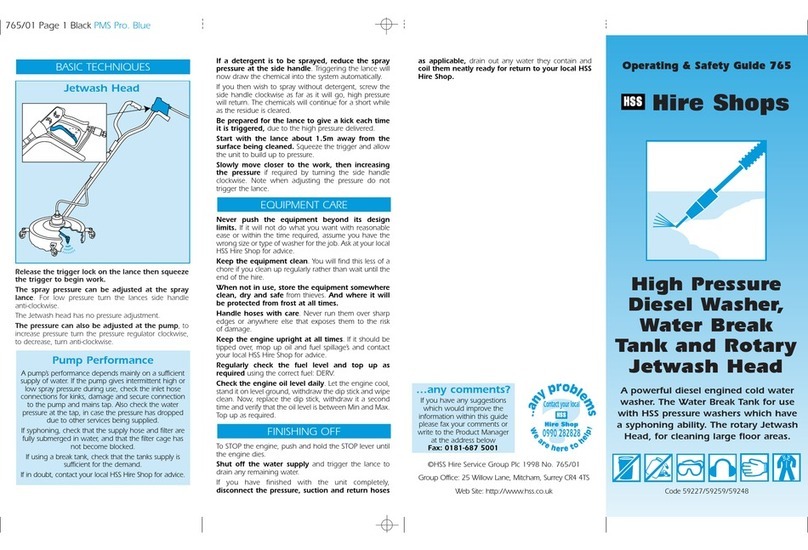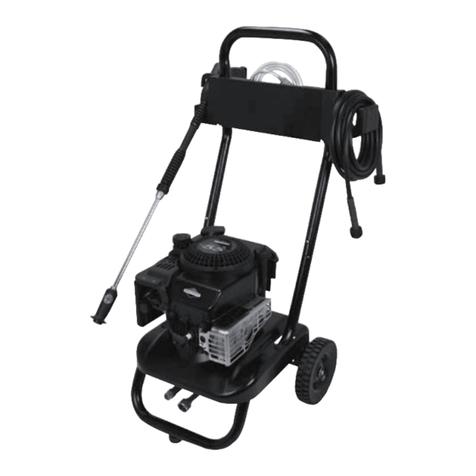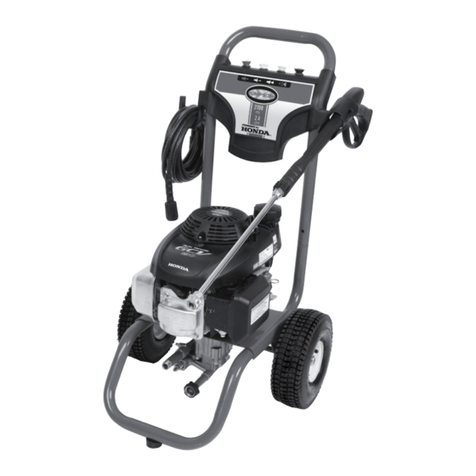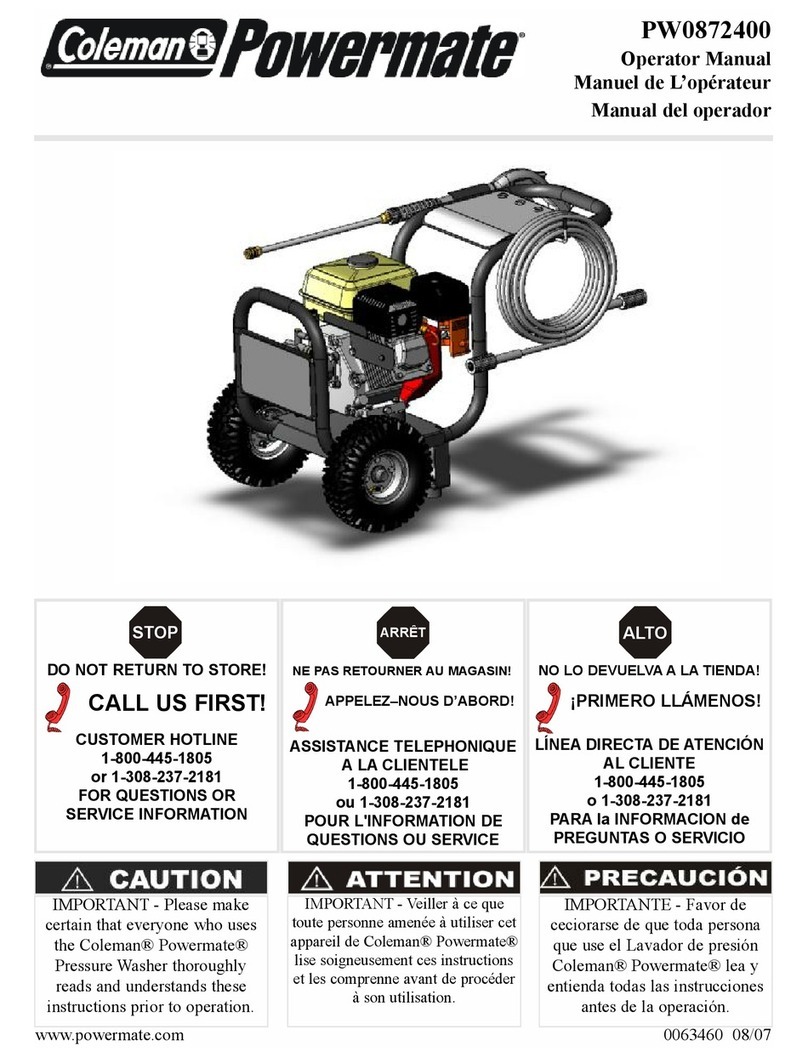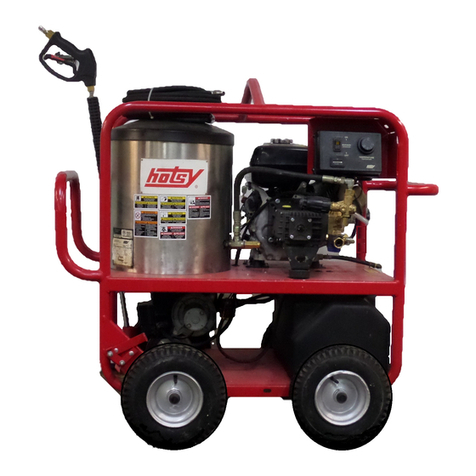Sherwin-Williams 2800 User manual

OWNER’S MANUAL
820-1
80
Rev A
This
manual
contains Important
Warnings and Instructions.
Read
the
manual and keep
i!
for
reference.
/?>
{,
:.
I:,
“.?I
..........
j
..
:,’<.
..
.L
......
9
HP
ENGINE
Model
2800
PRESSURE
WASHER
PIN
820-175,
Series
A
28OOpsi’(lQB
bar)
OPERATING PRESSURE
3200 psi
(224 bar)
MAXIMUM
WORKING PRESSURE
TABLE
OF
CONTENTS
Warnings
.........................
2
.
Installation
.......................
5
startup..
.........................
6.
Shutdown, Flushing and Storage
....
8
Maintenance
......................
8
PartsDrawing8Lists 10
Troubleshooting Chart
......
.I..
...
9
Pump Sewice
....................
14
Accessories
.....................
15
Technical Data
...................
15
Warranty
................
Back Cover
v.
....
.............
\
........
\
.F”
The
SHERWIN-WILLIAMS COMPANY, CLEVELAND,
OHIO
441 15

HIGH PRESSURE SPRAY CAN
CAUSE
SERIOUS
INJURY.
FOR
PROFESSIONAL USE ONLY OBSERVE ALL WARNINGS.
Read and understand all instruction manuals before operating equipment.
..
.
FLUID lNJECTlON HAZARD
,,
.
..
.,.. ,...
"
&A"YAr&.?
~;~&$~p~q%qy:
;%
~
,
..
.~
,-
General Safety
This pressure washer generates very high fluid
components can inject fluid through your skin and into
pressure. Spray from the gun, leaks or ruptured
your body,
and
cause extremely serious bodily injuq
including the need for amputation. Also, fluid injected or
damage.
splashed into the eyes or on the skin
can
cause serious
NNER
point the spray gun or wand at-anyone or at any
part of the body.
NWfR
put hand or fingers over the
spray tip.
ALWAYS
follow the Pressure Relief Procedure, before
cleaning or selvicing any part
of
the sprayer.
NEVER
try
to
stop or deflect leaks with your harid.or
body.
properly before each use.
Be sure equipment safety devices are operating
Medical Treatment
If
any fluid appears to penetrate your skin, get
EMERGENCY MEDICAL TREATMENT AT ONCE.
DO
NOT TREAT AS
A
SIMPLE CUT. Tell the doctor exactly
what fluid was injected.
NOTE TO PHYSICIAN: lnjection
in
the skin
is
a
traumatic
injuv.
It
is
important to treat the injury
surgically
as
soon
as
possible.
Do
not delay
treatment to research toxicify roxicify
is
a concern
bloodstream. Consultation with a plastic surgeon or
with some exotic coatings injected directly into the
reconstnrctive hand surgeon may be advisable.
i
_.?
.
..
2
Pressure Relief Procedure
To reduce
the
risk of serious bodily injury, including fluid
injection and splashing in the eyes or on the skin, always
follow this procedure whenever you stop spraying for
more
than
10
minutes, when
shutting
down, and before
checking.or repairing any part of the system.
1.
2.
3.
4.
5.
6.
Engage the trigger safety latch.
.Turn the sprayer
off.
Remove the ignition cable from the spark plug.
Shut
off
the water supply.
Disengage the trigger safety latch and trigger the
gun
to
relieve pressure, and then engage the trigger
safety latch again.
Before long-term (overnight) storage or transport-
ing
of
the unit, disconnect the water supply and turn
off
the fuel supply valve.
Spray Gun Safety Devices
Be sure all gun safety devices are operating properly
before each
use.
Do not remove or modify any part of
the gun; this can cause a malfunction and result in
serious bodily injury.
SAFETY LATCH: Whenever you
stop
spraying for a
or "safe" position, making the gun inoperative. Failure
moment, always set the gun safety latch in the engaged
to properly
set
the safety latch can result in accidental
triggering of the gun.
SPRAY
TIP
SAFETY: Use extreme caution when
cleaning or changing spray tips.
'.
..
820-
180

EQUIPMENT MISUSE HAZARD
General Safety
System
Pressure
Any misuse
of
the pressure wisher or accesw)ries,
such
Bs
overpressu~~n~,
modifying using This sprayer can develop high operating pressures. Be
incompatible chemicals and fluids,
or
using
or
sure that all spray equipment and accessories are rated
damaged
parts,
can
them
to
and to withstand the maximum working pressure of this
other serious bodily injury, fire, explosion or property Pressure
of
any component or accessory used in the
in fluid injection, splashing in the eyes or on the skin, or sprayer.
Do
exceed
the working
damage. system.
'
.
NEVER
alter or modw any part of this equipment; doing
so
could
cause
it
to
malfunction.
Chemical
Compatibility
CHECK
all spray equipment regularly and repair or
replace worn or damaged pm immediately.
BESURE
that all chemicals used in the chemical injector
ALWAYS
wear protective eyewear and appropriate are compatible with the wetted parts
of
the hose, gun,
clothing.
If
using a chemical injector, read and follow the wand and tip, as given in the Technical Data (inside back
chemical manufacturer's literature for recommenda- cover). Always read the chemical manufacturer's
tions on additional protective equipment, such as a
.
literature before using any chemical
in
this pressure
respirator.
..
washer.
HOSE SAFETY
..
High pressure
fluid
in the hoses can be very dangerous.
'
If
the hose develops a leak, split or rupture due
to
any
spray emitted
from
it can cause
a
fluid injection injury or
kind of wear, damage or misuse, the high pressure
other serious bodily injury or property damage.
pJ
(..?*,
AU FLUID HOSES
MUST
HAVE STRAIN RELIEFS ON
.<+>?
\i...
BOTH ENDS.
The strain reliefs help protect the hose
-ui.
from
kinks or bends at or close to the coupling, which,
can result in hose rupture.
TlGHTENall fluid connections securely before each use.
High pressure fluid can dislodge a
loose
coupling or
allow high pressure spray to be emitted from the
coupling.
NEVER
use
a
damaged hose. Before each
use,
check
entire hose for cuts;leaks, abrasion, bulging cover, or
damage or movement of the hose couplings.
If
any of
these conditions exist, replace the hose immediately.
DO
NOT
try to recouple high pressure hose or mend
it
with tape or any other device.
A
repaired hose cannot
contain the high pressure fluid.
HANDLEAND ROUTE
HOSES
CAREFULLY
Do
not pull
on hoses to move the pressure washer.
Do
not
use
chemicals which are not compatible with the inner tube
temperatures above
200°F
(93°C)
or below
-4OaF
and cover of the hose.
DO
NOT
expose Graco hose
lo
(-40°C).
FUEL AND EMISSION
HAZARDS
NEVER
fill the fuel tank while the unit
is
running or hot. odorless, invisible gas which can
cause
serious injury or
The fuel used in this
unit
is
combustible and when death
if
inhaled.
ALWAYSfill
tank slowly to avoid spilling.
spilled on a hot surface can ignite and cause a fire.
NW€R
alter the throttle setting, which
is
factory set.
NNER
operate the unit in
a
closed building. The Tampering with this adjustment can damage the
exhaust contains carbon monoxide, a poisonous, pressure washer and will void the warranty.
820-180
3

MOVING
PARTS
HAZARD
body parts.
K€€P
CLEAR
of moving parts when starting Pressure
Relief
Procedure before checking or
Moving parts
can
pinch or amputate fingers or other and interiocks installed and functioning. Follow the
or operating the pressure washer. servicing the pressure washer
to
prevent discharging
NNER
operate
the
pressure washer without all guards
TERMS
WARNING:
Alerts
user
to
avoid or correct conditions
NOTE
Identifies helpful procedures and information.
that could cause bodily injuty.
CAUTION
Alerts user
to
avoid or correct conditions
that could cause damage
to
the
equipment.
high pressure fluid
from
the gun.
..
.
IMPORTANT
United States Government safely standards have been adopted under the Occupational Safety and Health
Act.
These
standardsparticularly the General Standards, Part 1910, and the Construction Standards, Part 1926-should be
consulted.
4
820
-
1
80

INSTALLATION
PRESSURE HOSE
CONNECTION
INLET WATER
COUPLER
CONNECTION
314"
GARDEN HOSE
Figure
1
Check for Shipping Damage
Check the unit for any damage that may have occurred
In
shipping. Notify the
carrier
immediately
if
there
is
Set
Up
If you
are
using
a
downstream chemical injector, install
it between the pump unloader and the high pressure
hose, using the quick couplers provided.
chemical injector) outlet and the gun inlet. Both
of
these
Connect the high pressure hose between the pump (or
connections are made with quick couplers.
fi.!?.!,
t';:J
2
any damage.
CAUTION
Up to
100
ft
(30
m)
of high pressure hose may
performance, and chemical injector performance,
be used. Longer hoses may affect sprayer
Install
the
appropriate spray tip on the wand.
See
Installing and Changing Spray Tips. If you are using a
sandblaster kit, see
its
separate manual for installation
instructions.
Connect
to
Water Supply
CAUTION
Before attaching to the water supply, check your
to
the water supply.
A
backflow preventer,
P/N
local plumbing code regarding cross- connection
contaminated water into the fresh water supply.
801-133,
is available to prevent backflow
'of
Install it upstream from the pump.
If
inlet water pressure is over
60
psi
(4.1
bar) a
regulating water valve,
P/N
800-258,
must be
installed at the garden hose connection.
Do not exceed
160°F
(70°C) inlet water
temperature.
Connect a hose with at least a
3/4
inch
(19
mm) ID from
the water supply
to
the unit's
314
inch garden hose inlet.
The supply hose should not be more than
50
ff
(15
m)
long.
NOTE:
The
water source at the unit
must
have a
minimum flow rate equal
to
that
of
the unit
(see
Technical
Data, inside back cover).
820-
180
5

STARTUP
Always use this startup procedure
to
ensure that the unit
is
started safely
and
properly.
1.
Check oil levels.
Engine: Add SAE
30
or
low30
weight detergent oil as
necessary.
Pump: Add SAE
20
or
30
weight non-detergent oil as
necessary.
NOTE
This unit is equipped with a low-oil sensor that
shuts the engine
off
if
the oil level falls below a certain
level.
If
the unit stops unexpectedly, check both the oil
and the fuel levels. Check the oil level each time the una
is
refueled.
2.
Check fuel level.
WARNING
DO
NOT
refuel a hot engine. Refueling a hot
regular or unleaded gasoline. Close the fuel
engine could cause a fire.
Use
only fresh, clean
shutoff valve during refueling.
3.
Turn on the water supply.
ICAUTION1
will result. Always be sure the water supply
is
Never run the unit dry. Costly damage to the pump
completely turned on before operating.
4.
Trigger the gun until water sprays from the tip
indicating that the air
is
purged from the system.
5.
Open the fuel shutoff valve. Be sure the spark plug
On
those units equipped with an ignition shutoff
ignition cable
is
pushed fiirmly onto the spark plug.
the throttle in the "run" position.
switch, put the switch in the "on" position and put
6.
Start the engine.
NOTE
For easier starting, have one person start the
pressure washer while another person triggers the
spray gun.
If
the engine
is
cold, completely close the engine choke.
Grasp the starter rope, brace one foot on the pressure
washer chassis and pull rope rapidly and firmly.
Continue holding the rope
as
it
returns. Pull and return
the rope until the engine
starts.
In cool weather, the
choke may have
to
be kept closed for
10
to
30
seconds
before opening
it
to keep the engine
running.
Otherwise, open the choke as soon as the engine
starts.
ifthe engine is warm, leave the choke open, or just partly
close
it.
Start
the engine as described in the preceding
paragraph. When
it
starts, be sure
to
open the choke
completely.
CAUTION
On recoil start engines, never let the starter rope
return by itself.
It
could jam the recoil system.
7.
ALWAYS
engage the gun's trigger safety latch
whenever you stop spraying, even for a moment,
to
reduce the risk of fluid injection or splashing in the
accidentally.
eyes or on the skin if the gun is bumped or triggered
8.
ALWAYS
observe
the
following
CAUTIONS
to avoid
costly damage
to
the pressure washer.
CAUTION
than
10
minutes. Doing
so
may cause the
DOfiOTallowthe pressure washerto idleformore
recirculating water
to
overheat and seriously
damage the pump. Turn
off
the pressure washer
if
it
will not be spraying or cleaning at
least
every
this time further.
10
minutes.
If
heated inlet water
is
used, reduce
DO
NOT
run the pump dry, which will quickly
damage the pump. Be sure the water supply
is
fully turned on before starting the pump.
DO NOT
operate the pressure washer with the
inlet water screen removed. This screen helps
keep abrasive sediment out of the pump, which
could clog or scratch the pump. Keep this screen
clean.
DO
NOT
pump caustic materials; such materials
may corrode the pump components.
....
9.
See
the chemical injector or sandblaster kit manual
for detailed cleaning information
if
these accesso-
ries are used.
6
820-180

Trigger
Safety
Latch
WARNING
To
reduce
the
risk
of
serious bodily injuly,
including fluid injection, splashing in the eyes or
on
the
skin,
ALWAYS
engage
the
trigger safety
latch whenever spraying stops, even for a
moment.
In
the
engaged position, the trigger safety latch
tally by hand or
if
it
is
dropped or bumped.
Be
sure
prevents
the
gun from being triggered acciden-
the
latch is pushed fully down when engaging
it
or
1
cannot prevent the gun
from
being triggered.
See
Figure 2.
,.
.
..
TRIGGER SAFETY LATCH SHOWN ENGAGED
TRIGGER
SAFEPT
LATCH
SHOGN
Figure
2
DISENGAGED
installing
and
Changing
Spray
Tips
I
WARNING
1
To
reduce
the
risk
of
serious bodily injury,
onto the skin,
use
extreme caution when
including fluid injection or splashing in the eyes or
changing spray tips.
ALWAYS
follow the proce-
dure below.
1.
Follow the Pressure
Relief
Procedure:
2.
Point the gun and wand away from yourself and
anyone else.
3.
Without holding your hahd over the spray tip
(A),
pull back the quick coupler ring
(B).
Remove the old
tip andlor install a new one, and then
release
the
ring.
See
Figure
3.
4.
Be sure the tip
is
secure before starting to spray
again.
5.
Tip holding holes are provided in the chassis.
CAUTION
To
avoid blowing the o-ring out of the quick
coupler, due to the high pressure in the system,
Figure
3
020
-
1
00
7

SHUTDOWN, FLUSHING
AND STORAGE
,
.
WARNING
Pressure
Relief
Procedure
To reduce the' risk of serious bodily injury,
including fluid injection and splashing
in
the eyes,
or on the skin, always follow this procedure
whenever you stop spraying for more than
10
minutes, when shutting down, and before
checking or repairing any part of the system.
1.
Engage the trigger safety latch.
2.
Turn the sprayer
off.
3.
Remove the ignition cable from the spark
Plug.
4.
Shut
off
the water supply.
5.
Disengage the trigger safety latch and trigger
the trigger safety latch again.
the gun to relieve pressure, and then engage
6.
Before long-term (overnight) storage or
transporting of unit, disconnect the water
supply, and turn
off
the fuel supply valve.
1.
If
the pressure washer
will
be exposed
to
freezing
temperatures, drain all water out
of
the pump.
If
it
must be stored in freezing temperatures, flush the
unit with a
50%
anti-freeze solution. Relieve
pressure. Flush the pressure washer before using
it again
to
remove the anti-freeze.
NOTE
An
anti-freeze flush kit,
P/N 802-327,
is
available
to
make flushing easier.
CAUTION
If
water does freeze in the pressure washer, thaw
it
in a warm room before trying to start it.
DO
NOT
pour hot water on or into the pump; it may crack
2.
After each use, wipe all surfaces of the pressure
washer with a clean, damp cloth.
3.
Perform the appropriate maintenance. See mainte-
nance chart.
MAINTENANCE
that you get maximum petformance and life from
the
Observing regular maintenance intervals helps ensure
pressure washer.
There
is
a break-in period for the engine and pump.
After changing
the
oil in these components following
their respective break-in periods, the interval between
required changes is longer.
If
the unit
is
operating in dusty conditions,. these
maintenance checks should be made more often.
-.
.
..
1"
WARNING
..
i
I
To reduce the risk of serious bodily injury,
on the skin or injuty from moving palts, always
including fluid injection, splashing in the eyes or
follow the Pressure Relief
Procedure Warning
before proceeding.
I
I
Interval
What
to
do
Daily Clean water inlet screen and
filter. Check engine and pump
oil
levels. Fill
as
necessaty.
Check gasoline level. Fill
as
necessary.
After first
5
hours of
Change engine break-in oil.
operation
Drain
oil
when warm.
Use
SAE
30
or low30 detergent
oil.
Each
25
hours Clean and remove air cleaner
of operation foam. Wash with water and
detergent. Dry thoroughly. Rub
with oil and squeeze to
distribute oil.
After first
50
hours
of
operation
Change pump break-in oil. Use
SAE
20
or
30
non-detergent oil.
Each
100.
hours of
operation
or
3
months
Each
500
hours of
operation
Dr
6
months
Clean or replace paper air
cleaner cartridge. Tap gently
to
remove dirt. Change engine oil.
Use SAE
30
or
IOW-30
detergent oil.
Change pump oil. Use
SAE
20
or
30
non-detergent oil.
820-
180

TROUBLESHOOTING
CHART
WARNING
1
To
reduce
the
risk
of
serious
bodily
injury,
including
fluid
injection,
splashing
in
the
eyes
or
on
the
skin
or
injury
from
moving
parts,
always
follow
the
Pressure
Relief
Procedure
Warning
before
proceeding.
,$,j,:,f;)
/.m
,.,.
,
.I
.~&,.
,
.
,
,.
,
. .
..
PROBLEM
Engine will not
stat?
or
is
hard
to
start
Engine misses or lacks
power
Low
pressure andlor
pump
NnS
rough
Water leakage from
underpumpmanifold
Water in pump
Frequent or premature
hilure of the packings
jtrong, surging at the
nletandlowpressureon
he discharge side
CAUSE
No gasoline in fuel tank or carburetor.
Low oil
StarVstOp switch
in
Stop position.
Water
in
gasoline or old fuel.
Choked improperly. Flooded engine.
Dirty air cleaner filter.
'.
Spark plug dirty, wrong gap or wrong
type.
Spray
gun
closed.
Partially plugged air cleaner filter.
Spark plug dirty, wrong gap
or
wrong
type.
Worn or wrong size tip.
Inlet filter clogged.
wear.
Wornpackings.abrasivesinwaterornatura1
Inadequate water supply.
Fouledordirtyinletordischargevalves.Even
asmall particle can cause thevahre lo stick.
Restricted inlet.
Worn inlet or discharge valves.
Leaking high pressure hose.
."<
.
..
Worn packings,
Humid air condensing inside crankcase.
Worn packings.
Dil seals leaking.
Scored, damaged
or
worn plungers.
4brasive material
in
the
fluid
being pumped.
nlet water temperature too high.
3verpressurizing pump.
5cessivepressureduetopartiallypluggedor
iamaged tip.
lump running too long without spraying.
iunnina
aumo
d~~
'oreign particles in the inlet or discharge
'dve or worn inlet andlor discharge valves.
~ ~~~ ~
SOLUTION
Fill the tank with gasoline, open
fuel
shut
off
valve.
Check fuel line and carburetor.
Add to proper level.
Move switch
to
Start
position.
Drain
fuel
tank and carburetor. Use new fuel and dry
spark plug.
Open choke and crank engine several times
to
clear
out
gas.
Remove and clean.
Clean, adjust the gap or replace.
Trigger spray
gun.
Remove and clean.
Clean, adjust the gap or replace.
Replace with
tip
of
proper size.
Clean. Check more frequently,
Check filter. Replace packings. See PUMP SERVICE.
Check water flow rate to pump.
Clean inlet and discharge valve assemblies. Check
filter.
See
PUMP SERVICE.
Check garden hose, may be collapsed or kinked.
Replace worn valves.
See
PUMP SERVICE.
Replace high pressure hose.
Install
new
packings.
See
PUMP SERVICE.
Change pump oil.
Install
new packings. See PUMP SERVICE.
Install
new
oil seals. See PUMP SERVICE.
Install new plungers. See PUMP SERVICE.
nstall proper filtration
on
pump inlet plumbing.
:heck water temperature; may not exceed
16OOF.
30
not modify any factory-set adjustments.
See
EQUIPMENT MISUSE
HAZARD.
:lean or replace tip. See Installing and Changing
spray lips.
Wer
run
pump more than
10
minutes without
;praying.
10
not run pump without water.
:lean or replace valves.
See
PUMP SERVICE.
9

PARTS
DRAWING
820-175
Model
2800
Pressure
Washer
!.
!.

PARTS
LIST
820-175
Model
2800
Pressure
Washer
REF
PART
NO.
NO.
DESCRIPTION
ON
NO.
NO.
DESCRIPTION
REF
PART
1
2
3
4
5
6
7
8
10
9
11
12
13
15
14
16
17
18
20
19
22
21
24
23
25
26
27
28
800-392
GUNB~WhJD ASSEMBLY
~~
29 803-925
HANDLE
lincl.
17. 191
1
30
800-641
FRONT
LEG
ASSEMBLY
801-504
,
181-867
801-1 11
NUT, Garden Hose
802-363
1
179-885
LABEL, Wamin
32 101-566
Na Nylon
LOck,'3/&16
803-900
ENGINE,
9
hp,
a
ondaOHV
1
1
33
m1
CHASSIS
802-127
SCREW,
Cap,
hex hd..
34
801-012
GROMMET, Rubber
35 801-367
BUMPER, Rubber
1
820-137
LABEL, ID
.
'
1
100-527
WASHER, Flat;
5/16
14
1 37 804-051
FILTEiUSTRAINER
38
803-083
LABEL, Kee From Freezing
804-391
LABEL, Model
2800
801-568
QUICK COUPLER,
3/8
Male
,
2
1 41 800-124
RP ASSEMBLY,
0004
802-579
HOSE, High Pressure,
3/8
x
50'
1
42 800-125
TIP ASSEMBLY, 1504
43
800-126
TIP ASSEMBLY,
2504
44
800-127
TIP ASSEMBLY,
4004
111-040
NUT. Nylon Lock,
5/16-16 10
-
45
'
801-907
WASHER, Flat
803350
GUN, Spray (see
308-51 1) 46 801-905
ADAPTER
801-941
SCREW, Cap. hex hd.
47 156-849
NIPPLE, Hex.
3/8
NPT
801-009
QUICK COUPLER.
114
Female
49 800-745
UNLOADER. Preset.
2800
DSi
154-636
101
-545
.
'
5/16-18~1.75 4
I
36 804-398
BRACKn, Pump Support
801-539
BUMPER
1 40 801-1 10
ADAPTER, garden Hose
801-569
COUPLING
1
5/16-18
x
1
4
48
801-709
.
PLUG
BUMPER,'Rubber
LABEL, Warning
LABEL. Caution
2
"
..
~ ~
.
. .
1
.31
'
800-377
H
s""'.
SEA
2A
SEMBLY
1
lincl.
13. 14.15)
WASHER, Flat,;5/8
COlTER PIN
4
50
802-627
NIPPLE, Hex,
2
318
NPT
x
1
14
NPT
800-743
PUMP-
~ ~ ~
1
803-740
WHEEL
8
TIRE ASSEMBLY
2
801-546
SCREW,
Cap,
hex
hd.
803-741
AXLE
1
318-16
X
1.25
4
100.023
WASHER,
Flat,
3/8
8
154-494
O-RING, Quick Coupler,
1/4
156-082
O-RING, Quick Coupler,
3/8
(not
shown)
AR
(not
shown)
AR
'
51
803-869
HOSE, Bypa&
52
801-523
NIPPLE.
112
NPT
53
"
8ol~ios
T.EE,l/2NpT-~
-
54 804-397
THERMAL RELIEFVALVE
55
801-090
QUICK COUPLER.
1/4
Male
.~
56
801-599
ie
Bare,
0004-~
~'
57 801-600
TIF:
Bare,
1504
58
801-601
TIP Bare.
2504
59 801-602
TI+
Bare;
4004
QTY
1
1
4
1
1
4
.1
2
1
1
1
1
1
1
1
1
2
1
1
1
1
820- 180
11

PARTS
DRAWING
800-743
Pump
Asse
I
,'
81
82
,/
I
I
/

PARTS
LIST
800-743
Pump
Assembly
REF
PART
NO.
NO.
2 801-651
1
804-405
4 KIT123
3 801-652
5
KIT123
6 KIT 123
7
KIT123
8
KIT123
9 KIT 124
11
KIT123
10 KIT124
12 803-265
13 803-266
14 804406
16 804407
15 803-268
17 KIT23
19 801459
18 804408
22 804-409
23 804410
25 804-412
24 804-411
26 803-273
28 801-753
27 801-488
29 804413
HEAD, Pump
DESCRIPTION
WASHER
SCREW
VALVE
SEAT,
Valve
SPRING
CAGE, Valve
CAP
VALVE ASSEMBLY
SCREW
COVER, Bearing
SPACER
O-RING
BEARING
.
SEAL,
Oil
CRANKCASE
DIPSTICK
GUIDE, Piston
ROD, Connecting
COVER, Rear
SCREW
SCREW, Cap
PIN
O-RING
O-RING
5
O-RING
O-RING
OM
REF PART
1
NO.
NO.
30 804414
8
8 31 803-919
32 803-918
33
804415
34
803-921
40
KIT130
41 KIT 130
43
KIT130
42 KIT 130
8
44
KIT130
2
45 KIT 130
1 48 801484
1
48
801485
47 801482
2
75 804416
49 801-483
1
76 804417
1
3
77
804-418
3
79 804420
1
1 80 801-469
81 804421
5
1
82 804-422
1 84 803-292
83 803-278
3
35 803-920
7a 804-419
WASHER
DESCRIPTION
RING, Anti-Extrusion
PISTON
WASHER
O-RING
NUT
O-RING
RETAINER, Packing
RING, Intermediate
PACKING
RING, Head
PACKING
SCREW, Cap
SCREW, Cap
WASHER
WASHER.
CRANKSHAFT
RING, Retaining
BEARiNG
SCREW
WASHER
FLANGE, Gas
SEAL,
Oil
WASHER
SCREW
O-RING
QN
3
3
3
3
3
3
1
1
1
1
1
1
1
1
4
4
1
1
4
4
Klt
6'
6
SPRING
7
CAGE,
Valve
8
6
6
VALVE
6
SEAT,
Valve
5
Valve
Assembly
6
O-RING
4
804-402
123
Oil
Seal
3
SEAL.Oil
17
801458
23
OW._
Descrlpthx
No.
Ref.
Part
No. No.
Repalr
KR
II I
:!*
I
VALVE
ASSEMBLY
II
6
124
Valve
Cap
804-403
Packing
804404
130
6
CAP
10
6
O-RING
9
40
O-RING
1
41
RETAINER,
Packing
1
Assembly
42
RING,
Intermediate
1
43
PACKING
1
44
PACKING
45
RING, Head
2
2
Item
11 consists
of
items 4 through 8.
-
.
See Pump Assembly illustration on previous page.
820- 180 13

-~
PUMP
SERVICE
WARNING
To reduce the risk of serious bodily injury,
including fluid injection, splashing In the eyes or
on the skin, or injury from moving parts, always
follow the Pressure Relief Procedure Warning
before proceeding.
NOTE The following metric wrenches are needed:
the individual repair sections and the pump parts page
M10,
M13
and M30. Repair
kB
are available. Refer
to
for more details. For the best results, use all parts in the
kits.
NOTE There are
two
different tool kits
to
aid in servicing
the pump. P/N
800-298
is used to ease installation of
packings. P/N
800-271'
includes the items in
800-298
and
tools
to
aid in the removal of packing retainers.
Valves
NOTE For a
set
of
six
valves, order P/N
8011172.
1.
2.
3.
. .-
.
..
4.
Remove the hex plug from the manifold using an
M30'wrench.
Examine the O-ring under the hex plug and replace
it
if
it
is
cut or distorted.
Remove the valve assembly from the cavity; the
assembly may come apart.
torque to
75
ft-lb
(103
Nm).
Install the new valve. Install the O-ring and hex plug;
NOTE Retorque the plug after
5
hours of operation.
Pumping Section
1.
Remove the eight capscrews and lockwashers from
the manifold using an
M13
wrench.
2.
Carefully separate the manifold from the crankcase.
NOTE It may be necessary
to
tap the manifold lightly
with a soft mallet
to
loosen.
ICA_lD*1
Keep the manifold properly aligned with the
damage
to
the plunger or seals.
ceramic plungers when removing
to
avoid
3.
Carefully examine each plunger for any scoring or
cracking and replace
as
necessary.
14
Servicing the Plungers
NOTE:
Plunger repair
kt,
P/N
801-474
is available to
replace retainers, O-rings. washers and backup rings for
three cylinders.
1.
2.
3.
4.
5.
6.
Loosen the plunger retaining screw five
to
six turns,
using an MlOwrench. Push the plungertowards the
crankcase
to
separate the plunger and retaining
screw.
the O-ring. backup ring and copper bearing/gasket
Remove the screw from the plunger and examine
washer. Replace these parts, if necessary, using kit
801474.
Remove the plunger and flinger from the plunger
shaft. Clean, examine and replace parts as
necessary.
Inspect the plunger shaft for oil leakage from the
crankcase.
If
leaking is obvious, replace the oil
seals. Otherwise,
DO
NOT remove these seals
as
they cannot be reused. An oil seal kit
is
available
to
replace the seals.
tightly grease the flinger and oil seal, if
it
is being
replaced, and replace them on the plunger shaft.
Then install the plunger.
Lightly grease the retaining screw and the~outer end
of
the plunger.
Place
the
washer, O-ring
and
backup
ring around the screw and install the screw through
the plunger. Torque
to
14.4
ft-lb
(19.5
Nm).
NOTE
If
you.plan to replace the packings, refer
to
Servicing the V-Packings.
7.
8.
Lubricate the outside of each plunger. Slide the
damage the seals.
manifold onto the crankcase, being careful not
to
Torque the screws
to
21.7
ft-lb
(29
Nm) following the
Install the capscrews and washers finger-tight.
tightening pattern (Figure
4).
Uneven tightening
may cause the manifold to bind or jam.
I
1
Figure
4
820- 180

Servicing
the
V-Packings
5.
packings only,
the
other includes the packings, rings
NOTE:
There
are
two
types of packing kits: one
is
and
retainers.
6.
1.
2.
3.
4.
Remove the manifold
as
outlined in the Pumping
Section.
for debris and damage.
Thoroughly clean the packing cavities
and
examine
Lightly grease the packing cavities and then replace
the packings
in
the
following order: head
ring,
v-packing, intermediate ring, head ring, v-packing
and packing retainer with the O-ring installed in the
retainer groove.
manifold. &amine the o-ring-and replace
it
if
it
is cut
or damaged.
Remove the v-packing and head ring. Pull
out
the
I
correct direction. Improperly installed parts will
cause
a malfunction.
intermediate retainer ring. Remove the second
I
v-packing
and
second head ring.
..
Inspect all parts and replace
as
necessaty. the Plungers.
~ ~ ~~ ~~ ~
7.
Reassemble the manifold as instructed
in
Servicing
ACCESSORIES
(Must
be purchased separately)
800-1 17
DOWNSTREAM CHEMICAL INJECTOR KIT ANTI-FREEZE FLUSH KIT 802-327
For flushing system with
50%
anti-freeze solution prior
For injecting harsh cleaning chemicals downstream
to
transporting or storing pressure washer in below
from
the
pump. freezing temperatures.
UPSTREAM CHEMICAL INJECTOR KIT
For injecting mild cleaning chemicals upstream into
the
pump.
800-257 INLET PRESSURE REGULATOR 800-258
Regulates inlet water pressure
to
60
psi
(4
bar)
maximum.
BACKFLOW PREVENTOR 801-133
supply. Install upstream of pump.
Prevent back-up of contaminated water into fresh
TECHNICAL DATA
Model
800-638
Engine (air-cooled,
4
cycle)
9
hp Honda OHV
Gasoline Tank Capacity
6.2
quarts
(6
liters)
Water Pump Maximum Working Pressure
2800
psi
(196
bar)
Water PumD Maximum Flow
3.5
aDm
113.2
Ium)
Inlet Hose Connection
-. .
3/4"
garden
hose
(f)
..
Weight
125
Ib
(57
kg)
Dimensions
Width
Length
36" (914
mm)
Height
21
"
(533
mm)
23.5" (597
mm)
Maximum Inlet Water Temperature 160-F
(70°C)
Wetted Parts
High
Pressure Hose Acrylonitrile and Buna-N cover and tube
Bypass
Hose
Synthetic yam and EPDM
Pressure Washer (including fittings) Anodized aluminum, Aluminum
or
bronze alloys, Brass Copper, Nylon-
composite, Ceramic, Buna-N on phenolic,
303, 304,
and
316
Stainless
steel,
Polymide-12 thermoplastic, Carbon steel. Zinc plate,
with
or without
yellow
chromate
is
a
registered bademark
of
the
DuPont
Cornpaw.
820-
180
15
PTFE
PTFE
PTFE
PTFE
PTFE
PTFE
PTFE
PTFE
PTFE
PTFE

THE SHERWIN-WILLIAMS WARRANTY
AND
DISCLAIMERS
WARRANTY
Graco warrants all equipment manufactured by
it
and bearing
its
name to be free from defects in materiil and workmanship on ths
date of sale by an authorized Gram distributor to the original purchaser for use.
As
purchaser's sole remedy for breach of this,,!;,,;:?
)
I,
ranty, Graco will, for a period of
twenty
four months fmm the date of sale, repair or replace any pad of the equipment proven de;S:?:',-
I
tiie.
This
warranty applies onlywhen the equipment
is
installed, operated and maintained in accordance with Graco's written
me
;',
ommendations.
This warranty does not cover, and Graco shall not be liable for, any malfunction, damage or wear caused by
faulty
installation, mis-
!,,
application, abrasion, corrosion, inadequate or improper maintenance, negligence, accident, tampering,
or
substitution of non-
Graco component parts. Nor shall Graco be liable for malfunction. damage or wear caused by the incompatibility with Graw
!;
\.
equipment
of
structures,' accessories. equipment or materials not supplied by Graco, or the improper design, manufacture, installa-
i;,
tion. operation or maintenance of structures, accessories. equipment or materials not supplied by Graco.
,,
This
warranty is conditioned upon the prepaid return of the equipment claimed to be defective to an authorized Gram distributor
.'
for verification
of
the claim. If the claimed defect
is
verified, Graco
will
repair or replace free
of
charge any defective parts. The
equipment
wilt
be returned
to
the original purchaser transportation prepaid.
If
inspection of the equipment does not disclose any
fs
defect in material or workmanship. repairs
will
be made at a reasonable charge, which charges may include the
costs
of pam,
labor and transportation.
DISCLAIMERS
AND LIMITATIONS
L:./
I;!.
The
tens
of
this warranty constlute purchaser's sole and exclusive remedy and
&
in lieu of any other warranties (express or
[i
implied), lncludlng warranty of merchantablllty or warranty
of
fitness
for
a
partlcular purpose, and
of
any non-contractual
;::
liabilities, including product liabilities, based on negligence or
strict
liability. Every form of liability for direct, special
or
consequential
1'
damages or loss is expressly excluded and denied. In no case shall Graco's liability exceed the amount of the purchase price.
Any
action for breach
of
warranty must be brought within
two
(2)
years of the date
of
sale.
!
..
EQUIPMENT
NOT
COVERED
BY
GRACO
WARRANTY
Graco makes no warranty, and disclaims all implied warranties
of
merchantablllty and fitness for
a
partlcular purpose, with
i
;
c:
respect to accessories, equipment, materials, or components sold but not manufactured by Gram.
These
items sold. but not
manufactured by Graco (such as engines, pumps, etc.) are subject to the warranty,
if
any,
of
their manufacturer. Graco
will
provide
:::.
purchaser with reasonable assistance in making any claim for breach of these warranties.
i.,
.
...
,.
,.
I
!.
t..,
.>.
.,..
..
..
li
I
'.
,
,,..
1.
,.
,.
~
.;:,>,
.;;,:
"
'I
,
,
...
."
,,
The SHERWIN-WILLIAMS COMPANY, CLEVELAND,
OHIO
44115
PRIMEDIN
USA.
820-180
2-93
Revlsed2-93
Table of contents
Other Sherwin-Williams Pressure Washer manuals
